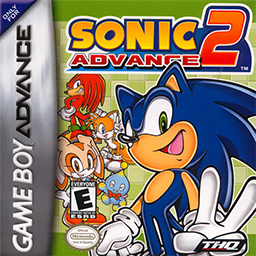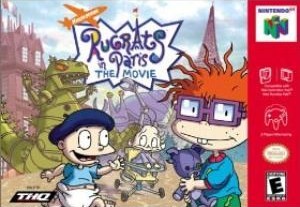
Mario Tennis is a 2000 sports video game developed by Camelot Software Planning and published by Nintendo for the Nintendo 64. Following Mario's Tennis, it is the second game in the Mario Tennis series. The game is known for being the introduction of Luigi's arch-rival, Waluigi, and the re-introduction of Princess Daisy and Birdo.

The Simpsons: Road Rage is a 2001 video game based on the animated television series The Simpsons, and is part of a series of games based on the show. It was released for PlayStation 2, Xbox and GameCube. A Game Boy Advance version was released in 2003. The Simpsons: Road Rage was later added to the Backwards Compatibility program of the Xbox 360 for original Xbox games.

Sonic Advance 2 is a 2002 platform video game developed by Dimps and published by Sega for the Game Boy Advance. It is an installment in the Sonic the Hedgehog series and the sequel to 2001's Sonic Advance. The story follows Sonic as he sets out to save his friends and retrieve the seven magical Chaos Emeralds from Dr. Eggman. Gameplay consists of the player completing various levels as one of five characters, each with their own unique attributes. After each zone is completed, the player faces Dr. Eggman in a boss battle.

The Simpsons: Bart & the Beanstalk is a platform game released in February 1994 for the hand-held console Game Boy. It was developed by Software Creations and published by Acclaim Entertainment, and is based on the animated television series The Simpsons. The game is a parody of the fairy tale "Jack and the Beanstalk"; a large beanstalk grows far up into the sky outside the home of Bart Simpson, whom the player controls. Bart climbs the beanstalk all the way to the top and adventure ensues. Bart & the Beanstalk has received mixed to negative reviews from critics.

Rugrats in Paris: The Movie is a video game based on the 2000 animated movie of the same name. The game follows the adventures of the Rugrats in a European theme park. A console version of the game was released in 2000, for the PlayStation, Nintendo 64, and a handheld version for Game Boy Color. A version for Microsoft Windows was later released in 2001. The console version's gameplay is similar to Rugrats: Studio Tour, but Paris’ attractions sometimes have minigames too. The handheld gameplay is a side-scrolling platformer. The Windows version's gameplay is an adventure game in which the player must find Chuckie's Wawa Bear.

Treehouse of Horror is a series of annual Halloween-themed anthology episodes of the animated sitcom The Simpsons. Also known as The Simpsons Halloween Specials, each episode typically consists of three separate, self-contained segments. Each segment involves the Simpson family in some comical horror, science fiction, or supernatural setting; plot elements operate beyond the show's normal continuity, with segments exaggeratedly more morbid and violent than a typical Simpsons episode. With 34 episodes as of 2023, each Treehouse of Horror episode is numbered in Roman numerals, one less than the respective season it is in.

SpongeBob SquarePants: Legend of the Lost Spatula is a 2001 platform action video game developed by Vicarious Visions and published by THQ for the Game Boy Color handheld game console. It is the first video game to be based on SpongeBob SquarePants. The game's story centers on SpongeBob SquarePants, a sea sponge who lives in the undersea town of Bikini Bottom and works for Mr. Krabs as the fry cook of the Krusty Krab fast food restaurant. SpongeBob is destined to become the ocean's greatest fry cook, and must embark on a quest to retrieve a golden spatula from the Flying Dutchman, a pirate ghost. The game features platforming-style gameplay, as well as many characters from the television series.

Buffy the Vampire Slayer is a 2000 beat 'em up game developed by GameBrains and published by THQ. Based on the television show Buffy the Vampire Slayer, the game features Buffy Summers, who fights vampires, demons, and other supernatural entities as the Slayer. The player controls Buffy through eight side-scrolling levels, and gameplay centers on one-on-one fights with vampires.

Buffy the Vampire Slayer: Wrath of the Darkhul King is a 2003 action platformer developed by Natsume and published by THQ for the Game Boy Advance. It was the third of six video games based on the television show Buffy the Vampire Slayer. The game follows Buffy Summers, who fights vampires, demons, and other supernatural entities as the Slayer. Set in the show's fourth season, the story focuses on Buffy's attempt to prevent a demonic warlord from initiating an apocalyptic event. The player controls Buffy through 16 side-scrolling levels that focus on solving puzzles and defeating enemies by using customizable weapons.

Scooby-Doo! Classic Creep Capers is an adventure game published by THQ for the Nintendo 64 and Game Boy Color, based on the Hanna-Barbera cartoon Scooby-Doo, Where Are You!. The Nintendo 64 version, developed by Terraglyph Interactive Studios, was released in November 2000, while the Game Boy Color version was developed by Digital Eclipse Software, and released in February 2001. A PlayStation version, identical to the Nintendo 64 version, had been in development by Terraglyph Interactive Studios but was later cancelled.

Monster House is a third-person shooter survival horror video game developed by Artificial Mind and Movement and published by THQ. The game is based on the 2006 animated film of the same name. The game was met with mixed reception.

Tomb Raider is an action-adventure video game developed by Core Design and released for the Game Boy Color by THQ under license from Eidos Interactive in 2000. A sequel, Tomb Raider: Curse of the Sword, was released in 2001.

Toy Story 2 is a 1999 side-scrolling platform game for Game Boy Color based on the film of the same name. The game was developed by Tiertex Design Studios and published by THQ. It was released in November 1999 in North America with the European version releasing the following year. The premise of the game loosely follows the original film with players taking control of Buzz Lightyear on a mission to rescue Woody by traversing through stages.

Commander Keen is a side-scrolling platform video game developed by David A. Palmer Productions and published by Activision in June 2001 for the Game Boy Color. Part of the Commander Keen series, it was released ten years after the first seven episodes in 1990–91. The game follows the titular Commander Keen, an eight-year-old child genius, as he journeys through three alien worlds to collect three plasma crystals to prevent the weapon they power, built by several enemies from previous games, from destroying the universe. The game features Keen running, jumping, and shooting through various levels while opposed by aliens, robots, and other hazards.

The Rugrats Movie is a traditional 8-bit 2D platform video game based on the movie of the same name from the Nickelodeon animated series, Rugrats. It was released for original Game Boy in November 1998 and for Game Boy Color in 1999. The game is also compatible with the Super Game Boy.

The Mask of Zorro is a 1999 Game Boy Color platform game developed by Saffire and published by Sunsoft, based upon and following the plot of the 1998 movie of the same name.

Action Man: Search for Base X is an action video game developed by Natsume Co., Ltd. and published by THQ under license from Hasbro Interactive for the Game Boy Color. It was released in North America on January 30, 2001, and is based on the Action Man TV series.

Gold and Glory: The Road to El Dorado is an adventure video game developed by Revolution Software. An adaptation of the film The Road to El Dorado, it was released on Game Boy Color, Microsoft Windows and PlayStation.

Rugrats: Time Travelers is a 1999 Game Boy Color game based on the Nickelodeon animated TV show Rugrats. It was developed by Software Creations Limited and released by THQ, Inc.

Croc is scrolling platform game for the Game Boy Color developed by British studio Virtucraft and published on 6 June 2000 by THQ under license from Fox Interactive and Argonaut Software. It is a 2D remake of the 1997 3D platform game Croc: Legend of the Gobbos with similar gameplay. The game follows Croc, a crocodile, on a quest to save a race of furry creatures called Gobbos from the evil Baron Dante. The game received mixed reviews from critics.



















